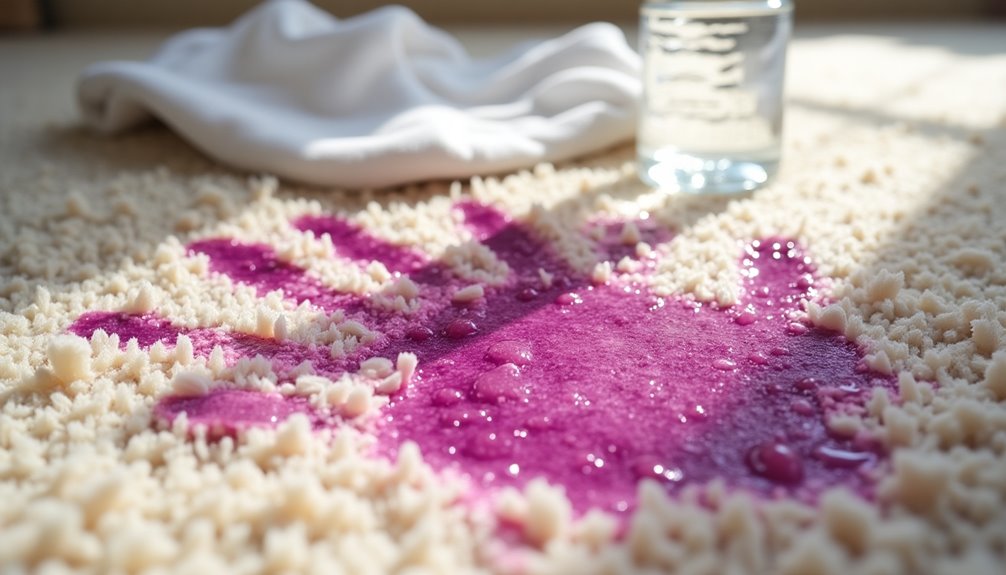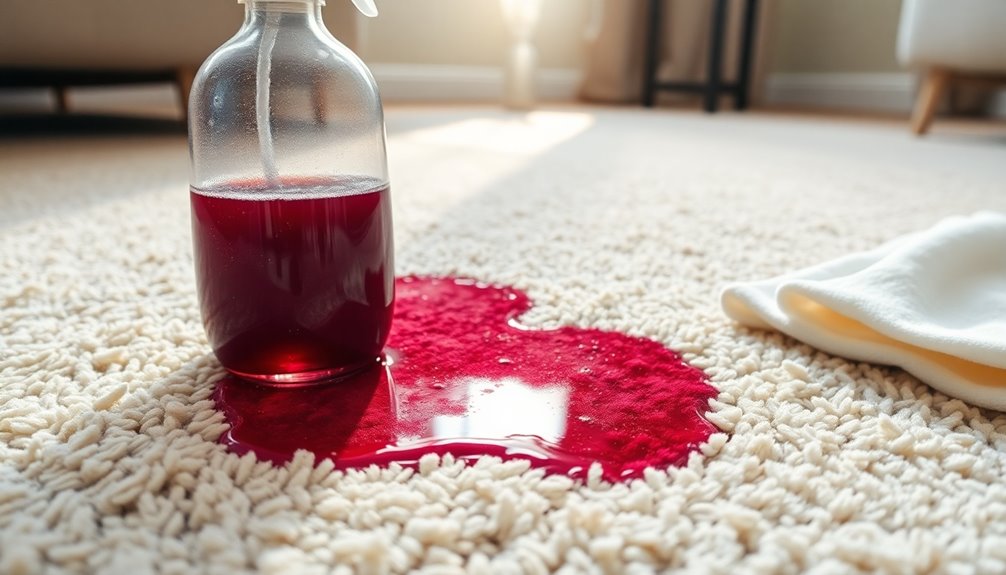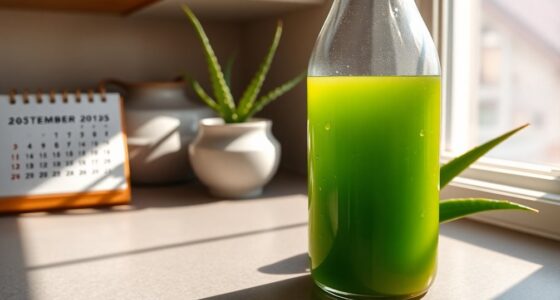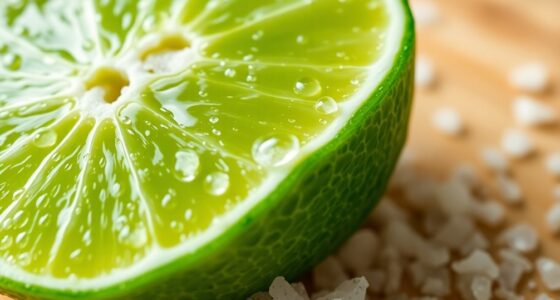To get grape juice out of your carpet, act quickly! Blot the stain with a clean cloth to absorb as much liquid as possible. Next, mix 1 tablespoon of dish soap with 2 cups of warm water and sponge the area gently. If needed, try a 1 tablespoon ammonia and 2 cups of warm water solution. Finish by rinsing with cold water and letting it dry completely. There's more to know about keeping your carpet looking great!
Key Takeaways
- Blot the grape juice spill immediately with a clean cloth to absorb the liquid without pushing it deeper into the carpet fibers.
- Mix 1 tablespoon of dish soap with 2 cups of warm water and sponge the stained area gently with the solution.
- For tough stains, use a mixture of 1 tablespoon of ammonia and 2 cups of warm water, blotting the stain effectively.
- Apply club soda to the stain with a clean cloth, which can help lift the grape juice if addressed quickly.
- Allow the area to dry completely, then vacuum to restore the carpet's texture and prevent mold or mildew.

If you've ever spilled grape juice on your carpet, you know how quickly those vibrant stains can set in. The key to success in removing that grape stain is acting fast. The moment you notice the spill, grab a clean cloth or paper towel and start blotting the area. Blot, don't rub; you want to absorb as much liquid as possible without pushing it further into the carpet fibers. Work from the outside of the stain towards the center to prevent it from spreading. You might feel a bit rushed, but staying focused will help you tackle the stain effectively.
Once you've blotted up as much of the grape juice as you can, it's time to bring in some cleaning solutions. A simple mixture of 1 tablespoon of dish soap and 2 cups of warm water can work wonders. Dampen a clean cloth with this solution and gently sponge the stained area. Keep blotting until you notice that the stain is no longer being absorbed into the cloth. This process might take a little time, but patience is key. You want to ensure you're doing a thorough job so that the grape stain doesn't leave any lasting marks.
If the stain turns out to be tougher than you expected, don't worry; there's another solution. Mix 1 tablespoon of ammonia with 2 cups of warm water. Apply this mixture to the stain in the same manner—blotting gently. Ammonia can be a powerful stain remover, but it's essential to make sure you rinse the area with cold water afterward. This step will help to remove any residual ammonia and prevent any lingering smells from infiltrating your home.
Alternatively, you can use club soda, which is surprisingly effective at lifting stains. Soak a clean cloth in club soda and blot the grape juice stain. As you do this, you should start to see the stain fade. Club soda can work wonders, especially if you catch the spill early enough.
After you've tackled the stain with your chosen method, let the area dry completely. This step is crucial, as moisture can lead to mold or mildew if left unattended. Once everything is dry, don't forget to vacuum the carpet. This will help restore its texture and fluffiness, making it look as good as new.
Frequently Asked Questions
What Removes Grape Juice From Carpet?
To remove grape juice from your carpet, act quickly! Blot the stain with a clean cloth to soak up the juice.
Mix one tablespoon of dish detergent with two cups of warm water, then sponge the stain, working from the edges inward. For stubborn marks, use a solution of ammonia and water.
You can also try club soda—just apply it directly and blot. Always test any cleaner on an inconspicuous area first!
Does Hydrogen Peroxide Remove Grape Juice Stains?
Does hydrogen peroxide really work on grape juice stains? Absolutely! Its bleaching properties make it a powerful option for tackling tough stains.
Just remember to spot test first to avoid any color issues. Mix it with dish detergent for even better results.
Apply the solution directly to the stain, blot gently, and let it sit for a few minutes. Finally, rinse the area with cold water to clear any residue and protect your carpet!
How Do You Get Grapes Out of Carpet?
To get grapes out of your carpet, start by carefully picking up any solid pieces to prevent further damage.
Next, use a clean cloth to blot the area, absorbing any juice that's escaped.
If there's a stain, mix a solution of dish detergent and warm water, then sponge the area, blotting until the liquid is absorbed.
Remember to rinse with cold water afterward to finish the job and prevent any lingering residue.
Will Grape Juice Stains Come Out?
Did you know that about 80% of stains can be removed if treated within the first 24 hours?
So, yes, grape juice stains can come out! If you act quickly, you can minimize the staining.
Blot the area with a clean cloth and try using a mixture of dish detergent and warm water. For tougher stains, consider club soda or ammonia solutions.
Just remember, the sooner you tackle it, the better your chances!
Conclusion
With a little patience and the right approach, you can wave goodbye to those pesky grape juice stains. Remember, the quicker you act, the better your chances of a successful removal. So, tackle the mess with a sprinkle of baking soda, a splash of dish soap, and a dash of vinegar. Soon, your carpet will look as good as new, and you'll be dancing on a clean surface, free from the shadows of spilled juice.
Cindy thoroughly researches juicing trends, techniques, and recipes to provide readers with practical advice and inspiration. Her writing style is accessible, engaging, and designed to make complex concepts easy to understand. Cindy’s dedication to promoting the advantages of juicing shines through her work, empowering readers to make positive changes in their lives through the simple act of juicing.











